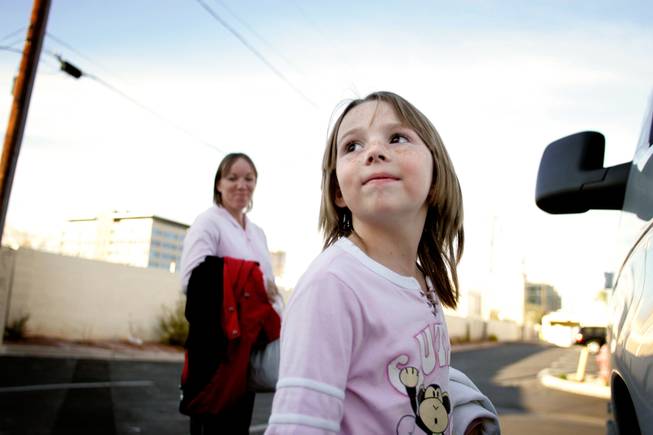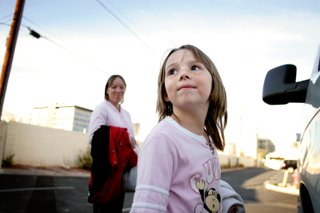
Seven-year-old Mariah Velasquez and her parents, Tricia and Daniel Velasquez, found themselves homeless and eventually split up about a year ago. They’ve since been reunited.
Wednesday, Feb. 13, 2008 | 2 a.m.
Sun Archives
- Donation a shoe-in for students in need (10-25-2005)
- Columnist Sandy Thompson: Group focuses on homeless kids' education (3-22-2002)
- New law to aid transient, homeless students (7-6-1998)
Shelly Hernandez’s voice broke with emotion as she recalled what a fourth grader told her a few weeks ago: She and her two sisters, all younger than 9, had been sleeping on the bare floor of a one-bedroom trailer.
Hernandez, a counselor at Will Beckley Elementary School, asked her colleagues at the school, “Can’t we at least get them sleeping bags and pillows?”
It was the first time in Hernandez’s 17-year career that she had to provide bedrolls for students.
Hernandez and hundreds of other Clark County School District counselors and teachers are confronting a troubling trend. The number of homeless children in district schools now totals 3,529, up 55 percent in just over a year. The district has identified nearly 400 newly homeless students since January.
At Beckley, Hernandez is working with 90 homeless students, compared with 25 last year. That means one out of every 10 students at that school lacks “a fixed, regular and adequate nighttime residence,” the federal government’s definition of homelessness.
Other schools, particularly in the east and southeast, face similar numbers, setting off alarms across the district.
Responses range from officials training teachers how to spot signs of homelessness to volunteers sending children home with snacks for the weekend. Or sleeping bags.
Experts say reasons for the rash of children without homes include heads of families losing jobs and the economy slowing. Then there are parents without job skills who veer off interstates into Las Vegas, dazzled by the idea of an easy paycheck, only to run into trouble matching wages to high rents. Plus there’s methamphetamine use, evident in one of every four families seeking help at one local agency. And, observers say, there’s a growing number of families that are one or two months from foreclosure.
It all adds up to a problem on which the district is spending at least $1.28 million in federal funding.
•••
In Mariah Velasquez’s case, homelessness has taken a toll on her emotions and her education.
Being homeless makes her “a little sad,” she says. The freckle-faced 7-year-old adds, “I’m angry sometimes.”
Daniel Velasquez later explains that his daughter sometimes shakes and shouts, which she never did before the family’s pick-up-and-leave living began about 12 months ago.
Mariah goes to Hollingsworth Elementary School, her second school in the past three months.
The family’s situation has improved, but it wasn’t long ago that most days started with only bread and butter for breakfast and ended with Mariah losing her homework and her temper.
“She couldn’t focus,” says her mother, Tricia Velasquez.
“It’s because of the homelessness,” her husband says.
•••
The district estimates, and social service agencies agree, that it probably has thousands more students who qualify as homeless but have yet to be identified. That’s why Myra Berkovits, coordinator of the district’s Title I HOPE program, is visiting schools, alerting teachers and asking for their help. HOPE stands for Homeless Outreach Program for Education.
She started last week at Sunrise Acres Elementary School, in the heart of the district’s east region, which has one of the highest percentages of homeless students.
Many of the district’s homeless students weren’t homeless when the school year started in August. That’s why teachers need to watch for changes in their students, Berkovits tells them.
“You are the first people who are going to notice,” she tells staff gathered in the library before class. “Do the kids seem tired? Hungry? How’s their personal hygiene? Are they showing up in the same clothes day after day?”
Erica Phillipson has learned to spot homelessness in the Sunrise Acres cafeteria.
She sees many of her kindergartners load up their trays at breakfast and lunch, since they may be the only meals they’ll have until they’re back in school the following morning.
“When their primary needs aren’t met, how are they supposed to learn?” says Phillipson, in her second year with the School District.
At breakfast, staff members put out rows of cereal, muffins and fruit. Students get to choose two items.
“One of my little boys took six,” Phillipson says. “He finished them all.”
•••
The district has numerous programs and partnerships that help thousands of needy children annually. In-school health centers at a handful of campuses, for example, offer students vaccinations, annual physicals and referrals for free and low-cost vision and dental care.
Operation School Bell, a program that began in the 1970s, provides clothing, notebooks and other supplies.
But such programs are being stretched thin.
At Beckley, Hernandez has sent 60 students to Operation School Bell and she has 40 more on the waiting list.
Kathleen Boutin, founder and executive director of the Nevada Partnership for Homeless Youth, wasn’t surprised that the School District is seeing an increase in needy students. Many of them are her own referrals, Boutin said.
Most of the kids she sees are high school age, and many attend schools in the southeast region.
The kids are typically ages 14 to 18, and most have been largely on their own for years, Boutin said. Many are “couch surfers,” staying a few nights at a time with family or friends, nothing close to permanent residency. They come to Boutin’s drop-in center, on Maryland Parkway across from UNLV, for food and clothes. Students gather regularly for homework sessions.
Last year the partnership helped nearly 1,500 teens, Boutin said. “My best guess is we’re getting half of them out there,” she added.
•••
While Boutin’s foundation targets teens, in recent years several district elementary schools have begun focusing on their most vulnerable students. With help from a variety of donors, schools have begun sending children home on Fridays with backpacks full of food to help them through weekends.
Corps of Compassion, another nonprofit organization, delivers 400 backpacks to a dozen district schools each week, including Sunrise Acres. More schools have asked for help in recent months, organization founder Scott Sullivan says.
The slowing economy has meant some families that weren’t homeless even a month ago are now on the verge, Sullivan says. He’s finding as many as 12 or 14 people sharing a single-family home where food is in short supply. And the youngest children are often the last to eat, Sullivan says.
He has met students who tell him they’ve learned to hide the contents of the backpacks from strangers crashing on the family’s couch and sometimes even from older relatives. Other children tell him they share the food with their families.
“Part of my mission is to educate the public of Las Vegas,” Sullivan says. “People don’t realize there are thousands of hungry children in this town. And it’s our responsibility to do something, because this is our community.”
The backpacks are making a difference in student achievement, says Eva White, deputy superintendent of the east region.
In the year since the program began, 75 percent of students have shown improved attendance, and more than half have also improved their grades.
“If you’re worried about food, it’s hard to pay attention to your reading assignment,” White says.
•••
Mariah Velasquez has returned from school with a backpack, a sleeping bag and, on Fridays, granola bars and Fruit Roll-Ups, and her parents say they have noticed how much easier it is for their daughter to focus on her homework in recent weeks.
But that’s largely because they had the good fortune to run across Family Promise late last year. Family Promise is the only program in the valley that allows homeless families in which both parents are present to stay together while they’re trying to rebuild their lives. Local churches give shelter to the families at night and caseworkers help them seek work and housing during the day.
Neither search has been easy for the Velasquezes, who are currently unemployed. They are among the thousands of typically $9-an-hour, single-breadwinner families that can get knocked down the drain of homelessness by just about any curveball that life throws them.
In their case, it was Tricia Velasquez’s dad breaking a collarbone last year in Idaho. She, her husband and their daughter picked up and left Las Vegas, leaving behind an apartment and Daniel’s maintenance job.
After caring for Tricia’s dad for four months, the family split up, with Daniel chasing a $12-an-hour job in Colorado and Tricia heading back to Las Vegas. Then Daniel returned to Las Vegas. But he couldn’t stay in the apartment Tricia was sharing with someone else. He wound up in a homeless shelter.
It was hardest around Thanksgiving and Christmas.
“I was missing them. I hate being apart. Now it’s better,” he says of their temporary residence at a church, clasping his hands to show a family reunited.
They hope to move into a low-rent home soon, with the help of yet another organization, Lutheran Social Services.
Terry Lindemann, executive director of Family Promise, says the problem of homeless children in the valley won’t go away until there are more programs to help out-of-work, undereducated and drug-addicted parents, as well as more affordable housing.
This is what Linda Lera Randle-El, director of a group called Straight From the Streets, calls stopping homelessness at the front door.
“How, all of a sudden, did we get 50 percent more children showing up? No one knows how they got there?”


Join the Discussion:
Check this out for a full explanation of our conversion to the LiveFyre commenting system and instructions on how to sign up for an account.
Full comments policy